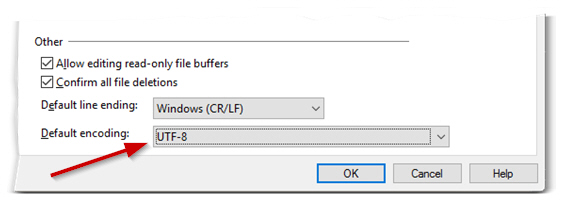

To achieve this, each character is converted into binary code, and for this, text documents are saved with encoding types. The computer understands only binary data hence it is required to convert these characters into numeric codes.
#TEXT ENCODING TYPES HOW TO#
It informs the computers how to interpret the zero and ones into real characters, numbers, and symbols. Type of Encoding TechniqueĬharacter encoding encodes characters into bytes.

In this topic, we are going to discuss the different types of encoding techniques that are used in computing. Note: Encoding is different from encryption as its main purpose is not to hide the data but to convert it into a format so that it can be properly consumed.
Encoding in Computing: In computing, encoding is a process of converting data to an equivalent cipher by applying specific code, letters, and numbers to the data. Encoding in Electronics: In electronics, encoding refers to converting analog signals to digital signals. Encoding works similarly to converting temperature from centigrade to Fahrenheit, as it just gets converted in another form, but the original value always remains the same. It is used to transform the data so that data can be supported and used by different systems. The process of conversion of data from one form to another form is known as Encoding. Load multiple Excel (*.xlsx, *.Next → ← prev Types of Encoding Techniques. Load Excel data table to a Python pandas dataframe. Get member details from an Outlook distribution list with Python.  Excel Formula: Find overlapping date ranges. Python pandas: lookup value for dates from date ranges. Here you can a find a list of python standards encoding. I do not really have a final conclusion here maybe only that file encoding matters and be cautious when working with CSV files and you know nothing about how they were created :). Print('Endcoding with chardet: ' + str(get_file_encoding_chardet(csv_file_path))) Print('Endcoding: ' + str(get_file_encoding(csv_file_path))) Get the encoding of a file using chardet packageĬsv_file_path = input('Please enter csv filename: ') Python Codeĭef get_file_encoding_chardet(file_path): In case of the first try I got back ‘cp1250’ for both files, in case of the second try I got back ‘ascii’ for the “simple” CSV and ‘UTF-8-SIG’ for the CSV UTF-8. I tried to identify a CSV file encoding in two ways (both found on Stack Overflow).Īt first I went for the encoding property of a file (first try), then secondly I tried out the chardet package (second try). So it is definitely better habit to save your Excel file as ‘CSV UTF-8’. Then I saved the very same file as CSV UTF-8, encoding came back as ‘UTF-8-BOM’: I saved a simple Excel file first as CSV, encoding came back as ‘Undefined’: In Sublime Text 3 there is very useful command: view.encoding() it is showing the current file encoding. Those who are interested in the encoding topic there is a good beginner article on the W3C (World Wide Web Consorcium) website.įrom an Excel user perspective I found another very descriptive post about how Excel creates CSVs. By searching for solution I concluded it is not as easy as I thought first, and basically the best if you know in advance what is the encoding type of your CSV file. At least that was the case with me when I used the pandas library and tried to create a data frame from a csv file, but continuously received a UnicodeError message and almost went crazy. Sometimes it is good to know what is the encoding type of the file you are working with.
Excel Formula: Find overlapping date ranges. Python pandas: lookup value for dates from date ranges. Here you can a find a list of python standards encoding. I do not really have a final conclusion here maybe only that file encoding matters and be cautious when working with CSV files and you know nothing about how they were created :). Print('Endcoding with chardet: ' + str(get_file_encoding_chardet(csv_file_path))) Print('Endcoding: ' + str(get_file_encoding(csv_file_path))) Get the encoding of a file using chardet packageĬsv_file_path = input('Please enter csv filename: ') Python Codeĭef get_file_encoding_chardet(file_path): In case of the first try I got back ‘cp1250’ for both files, in case of the second try I got back ‘ascii’ for the “simple” CSV and ‘UTF-8-SIG’ for the CSV UTF-8. I tried to identify a CSV file encoding in two ways (both found on Stack Overflow).Īt first I went for the encoding property of a file (first try), then secondly I tried out the chardet package (second try). So it is definitely better habit to save your Excel file as ‘CSV UTF-8’. Then I saved the very same file as CSV UTF-8, encoding came back as ‘UTF-8-BOM’: I saved a simple Excel file first as CSV, encoding came back as ‘Undefined’: In Sublime Text 3 there is very useful command: view.encoding() it is showing the current file encoding. Those who are interested in the encoding topic there is a good beginner article on the W3C (World Wide Web Consorcium) website.įrom an Excel user perspective I found another very descriptive post about how Excel creates CSVs. By searching for solution I concluded it is not as easy as I thought first, and basically the best if you know in advance what is the encoding type of your CSV file. At least that was the case with me when I used the pandas library and tried to create a data frame from a csv file, but continuously received a UnicodeError message and almost went crazy. Sometimes it is good to know what is the encoding type of the file you are working with.







 0 kommentar(er)
0 kommentar(er)
